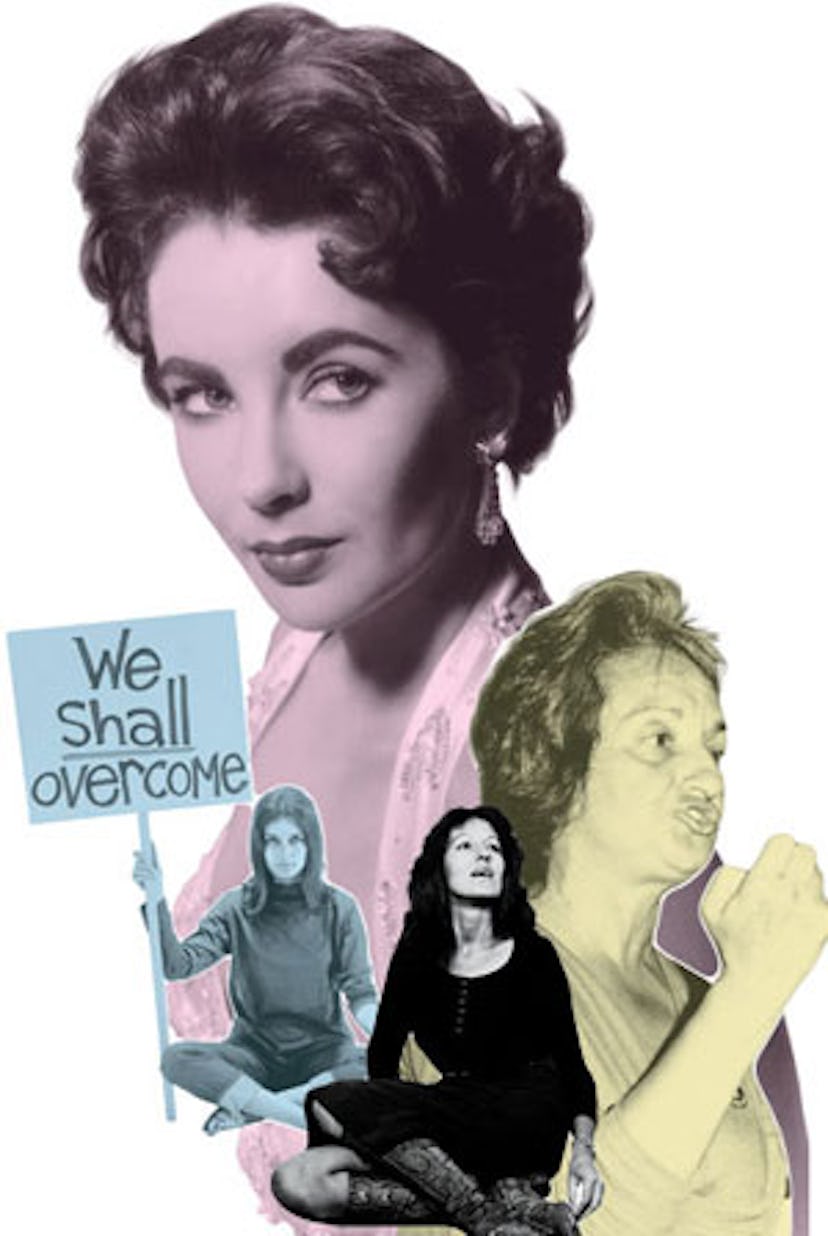Growing up, I rarely thought about Elizabeth Taylor—and never in the context of feminism, which I discovered in high school, thanks to Ms. magazine. By the late seventies, Taylor’s important films were behind her. She had married the Republican senator John Warner, whom cartoonist Garry Trudeau—my generation’s moral compass—called a “dim dilettante.” She would become the butt of Joan Rivers’s fat jokes. Even in 1985, three years into the AIDS epidemic, when Taylor came forth as a spokesperson and fundraiser for the stigmatized disease, I failed to connect her heroic actions with feminism.
Mystics often describe “peak experiences” as moments that crack open the shimmering mirage they had mistaken for truth. Some credit meditation—or LSD—with unlocking the doors of perception. In my case, however, it was some box sets of Taylor DVDs. I watched them with friends from Gen X and Gen Y, people too young to possess even my scant end-of-the-baby-boom awareness of the megastar in her heyday.
From the DVDs, we expected hours of guilty, campy pleasure. But what we saw—to our initial disbelief—was a feminist manifesto. It wasn’t that Taylor necessarily played feminist characters. Or that she had written or directed the movies. But over and over, her epic beauty drew crowds to brave, often subversive projects that challenged patriarchal ideas.
In National Velvet (1944), Taylor’s 12-year-old character deals with gender discrimination. Barred from riding in an important horse race because she is a girl, she poses as a male jockey and comes in first, exposing the absurdity of excluding women for supposedly being less capable than men. A Place in the Sun (1951) is essentially an abortion-rights movie—a harrowing glimpse into a time before women had easy access to birth control. In Butterfield 8 (1960), Taylor’s character is censured not because she’s a prostitute but because she chooses the men with whom she’ll sleep. She demands ownership of her body—a core feminist tenet.
In Giant (1956), Taylor portrays an educated Easterner committed to social justice who moves west to marry a bigoted Texas cattle baron. He’s contemptuous of women, but she transforms him. Taylor’s character in Suddenly, Last Summer (1959), which exposes the callousness of the male-dominated medical establishment toward women patients, dares to speak an awkward truth: Her aunt’s gay son was murdered by the urchins he’d propositioned. The situation is so embarrassing to her wealthy aunt that the old woman seeks to have her niece lobotomized. Even Who’s Afraid of Virginia Woolf? (1966), Taylor’s most celebrated movie, demonstrates what becomes of a woman when the only way society permits her to express herself is through her husband’s career or her children. Watching Taylor roar, “I am the Earth Mother, and you are all flops,” I thought of Betty Friedan’s landmark book, The Feminine Mystique. Women “who live without conflict or anxiety in the confined world of home have forfeited their own being,” Friedan wrote. “The others, the miserable, frustrated ones, still have some hope.”
My friends and I were gobsmacked. Had we for years been so distracted by Taylor’s searing beauty—or tabloid persona: eight marriages, recovery from addiction, million-dollar diamonds, and attempted rescue of Michael Jackson—that we overlooked such blazing messages?
In the Margaret Herrick Library of the Academy of Motion Picture Arts and Sciences in Beverly Hills, I found evidence that not everyone was blind to them. The Production Code Administration—which controlled the content of all studio movies from 1934 through 1967—saw precisely what we had seen and did its best to expunge it. For example, nearly all the censors’ memos on A Place in the Sun, starring Montgomery Clift, and Taylor as the rich girl he falls for after he impregnates his assembly-line coworker, demanded rewrites to obfuscate a scene in which the unmarried colleague, played by Shelley Winters, asks for an abortion. The censors also picked up on the alluring independence of Taylor’s character in Butterfield 8 who defiantly refuses to sleep with certain men no matter how much money they offer. They ordered revisions to make her character look “sick.”
Early in her career, Taylor—like the beautiful somnambulist in Harold Lloyd’s movie High and Dizzy who sleepwalked onto an upper-story ledge—strode unconsciously into risky territory, unaware of just how “out there” she was. Somewhere along the line, though, I suspect she woke up. Her 1987 memoir quotes Gloria Steinem and advances thoughts on body image put forth in Susie Orbach’s seminal book Fat Is a Feminist Issue.
I met Taylor only once, in 2001, before any connection between her and feminism had crossed my mind. I will never forget the intelligence I saw behind her famous violet eyes. When I began my new book about her, The Accidental Feminist, I had hoped to question her about my discovery. But her health was then too fragile to permit an interview. In a way, though, we don’t need a formal statement from her. Her films speak volumes—and offer different insights to different viewers. Those who knew Taylor at the height of her career may be startled to find an unexpected side to the icon; younger viewers may be justifiably alarmed to discover a recent past in which rights they take for granted—including abortion, interracial marriage, and certain sexual acts between consenting adults—were illegal.
In any case, you don’t have to take my word for the surprising content in those films. That’s the great thing about movies: You can see for yourself.
Photos: Getty images (2); Everett collection; Associated Press
